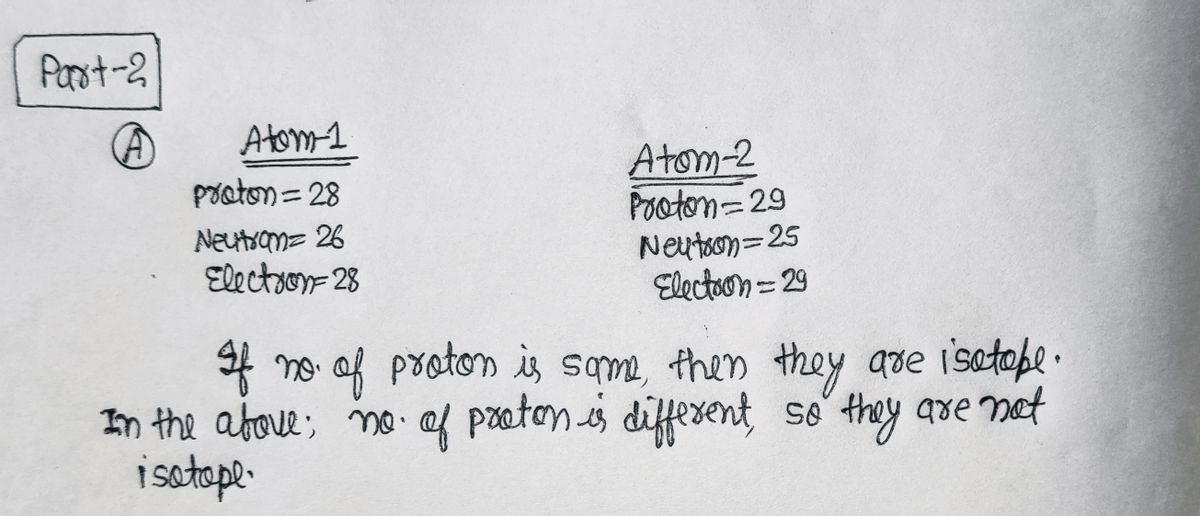2. For each part of this problem the subatomic particles of two atoms are given below. Write the isotope symbol that represents each atom and then identify the difference between the two atoms, are they different elements, isotopes, or ions? a. Atom 1 Atom 2 Protons = 28 Protons = 29 Neutrons = 26 Nuetrons = 25 Electrons = 28 Electrons = 29
2. For each part of this problem the subatomic particles of two atoms are given below. Write the isotope symbol that represents each atom and then identify the difference between the two atoms, are they different elements, isotopes, or ions? a. Atom 1 Atom 2 Protons = 28 Protons = 29 Neutrons = 26 Nuetrons = 25 Electrons = 28 Electrons = 29
Chemistry
10th Edition
ISBN:9781305957404
Author:Steven S. Zumdahl, Susan A. Zumdahl, Donald J. DeCoste
Publisher:Steven S. Zumdahl, Susan A. Zumdahl, Donald J. DeCoste
Chapter1: Chemical Foundations
Section: Chapter Questions
Problem 1RQ: Define and explain the differences between the following terms. a. law and theory b. theory and...
Related questions
Question
100%
Please answer number 2 letter A only

Transcribed Image Text:1. A new element is discovered! It is called Jessium, J. The atomic number of J is 119. If the
element has a mass number of 252 what is the number of protons, neutrons, and electrons that
make up an atom of J?
2. For each part of this problem the subatomic particles of two atoms are given below. Write the
isotope symbol that represents each atom and then identify the difference between the two
atoms, are they different elements, isotopes, or ions?
a. Atom 1
Atom 2
Protons = 28
Protons = 29
Neutrons = 26
Nuetrons = 25
Electrons = 28
Electrons = 29
b. Atom 1
Atom 2
Protons = 27
Protons = 27
Neutrons = 27
Nuetrons = 27
Electrons = 27
Electrons = 26
3. Following up on problem 1, consider again the new element Jessium, J, atomic number 119 and
mass number 252. Where will this new element be placed in the periodic table?
a. Report the group number and common name for the group J will be part of.
b. Report the period J will be part of.
c. Is Ja metal, non-metal, or metalloid?
Zoom
4. Continue considering the new element Jessium, J, atomic number 119 and mass number 252 to
answer the following questions about periodic trends.
Expert Solution
Step 1

Trending now
This is a popular solution!
Step by step
Solved in 2 steps with 2 images

Knowledge Booster
Learn more about
Need a deep-dive on the concept behind this application? Look no further. Learn more about this topic, chemistry and related others by exploring similar questions and additional content below.Recommended textbooks for you

Chemistry
Chemistry
ISBN:
9781305957404
Author:
Steven S. Zumdahl, Susan A. Zumdahl, Donald J. DeCoste
Publisher:
Cengage Learning

Chemistry
Chemistry
ISBN:
9781259911156
Author:
Raymond Chang Dr., Jason Overby Professor
Publisher:
McGraw-Hill Education

Principles of Instrumental Analysis
Chemistry
ISBN:
9781305577213
Author:
Douglas A. Skoog, F. James Holler, Stanley R. Crouch
Publisher:
Cengage Learning

Chemistry
Chemistry
ISBN:
9781305957404
Author:
Steven S. Zumdahl, Susan A. Zumdahl, Donald J. DeCoste
Publisher:
Cengage Learning

Chemistry
Chemistry
ISBN:
9781259911156
Author:
Raymond Chang Dr., Jason Overby Professor
Publisher:
McGraw-Hill Education

Principles of Instrumental Analysis
Chemistry
ISBN:
9781305577213
Author:
Douglas A. Skoog, F. James Holler, Stanley R. Crouch
Publisher:
Cengage Learning

Organic Chemistry
Chemistry
ISBN:
9780078021558
Author:
Janice Gorzynski Smith Dr.
Publisher:
McGraw-Hill Education

Chemistry: Principles and Reactions
Chemistry
ISBN:
9781305079373
Author:
William L. Masterton, Cecile N. Hurley
Publisher:
Cengage Learning

Elementary Principles of Chemical Processes, Bind…
Chemistry
ISBN:
9781118431221
Author:
Richard M. Felder, Ronald W. Rousseau, Lisa G. Bullard
Publisher:
WILEY